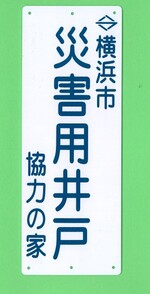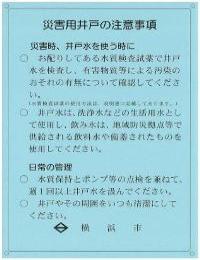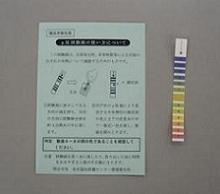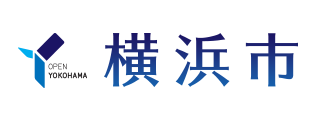- Yokohama-shi Top Page
- Living and Procedures
- Housing and Living
- Living Environment
- Comfortable living environment
- Information on hygiene measures in times of disaster, etc.
Here's the text.
Information on hygiene measures in times of disaster, etc.
Last Updated December 20, 2024
This is the site of Health Sanitation Division, Health and Safety Department, Yokohama City Public Health Center. We provide information on hygiene measures in the event of a disaster or flood.
Thank you very much for your cooperation in the inspection.
Contents
- Flow of procedures for designation of emergency wells for disaster
- Designation requirements for emergency wells
- Management after being designated as a disaster emergency well
- How to manage emergency wells
- Downloading applications, etc.
- Outlines and guidelines for emergency wells for disasters
- About the use of emergency wells
- Location and number of emergency wells in the city
About emergency wells
Yokohama City is looking for wells (disaster emergency wells) that will provide local people with "living water (*)" such as toilet and outdoor cleaning in the event of a disaster as "securing domestic water in the event of a disaster". I am.
※Do not use domestic water for drinking, cooking, food and dishwashing.
Flow of procedures for designation of emergency wells for disaster
If the owner of a well can be provided as domestic water in the event of a disaster.
↓
Request to Health and Welfare Center Health Sanitation Division in the ward where the well is located
↓
Survey of wells by Health Sanitation Division Health and Welfare Center (owners, etc. are required)
↓
When the designated requirements are met, designated as a disaster emergency well※
If the specified requirements are not met, advise on improvement of facilities, etc.
↓
If the designated requirements are met due to improvement, etc., designated as a disaster emergency well※
※In the case of designation, we hand well designation letter of advice for disaster emergency, "house of well cooperation for disaster" plate.
Designation requirements for emergency wells
Wells that meet the following requirements are designated as emergency emergency wells for the quality of well water and the structure of wells so that they can be used as "living water (*)" for cleaning toilets and outdoors in the event of a disaster.
Well or spring water in the city. There must be an owner, etc.
We designate well (spring) in Yokohama-shi where owner or manager is to confirm that we perform daily management.
Meet the water quality standards (pH, odor, chromaticity, turbidity) specified in the outline, and the well body and surrounding conditions must be clean.
The standards for water quality specified in the outline and the standards for the structure of the well are as follows.
| Items | Criteria |
|---|---|
| pH | 5.8 or more and 8.6 or less |
| Odor | Not abnormal |
| Chromaticity | 5 degrees or less |
| Turbidity | 2 times or less |
| Items | Criteria |
|---|---|
| Lifting the well | It must be at least 15 centimeters |
| Lid | It must be waterproof. In addition, there must be no water contamination at the top. |
| Peripheral conditions | There must be no contamination of wells |
required items, such as the location of wells or springs, the name of the owner, etc., can be made known to the residents of the city.
When designated as a disaster emergency well, the name of the well owner, the location of the well, etc. will be posted on the disaster emergency well list issued by Yokohama City.
This list will be available at evacuation shelter, Neighborhood Associations, Neighborhood Association and ward offices for use in the event of a disaster.
Since the roster can be viewed by anyone, it is designated as a disaster emergency well when consent is obtained to disclose the location of the well and the name of the owner. .
Management after being designated as a disaster emergency well
Distribution of goods to well owners (such as "House for Disaster Well Cooperation" plate)
In the case of emergency designation, we hand the following three to owners.
1."House for Disaster Well Cooperation" Plate
⇒Post it in a place that is easier for neighbors to understand (for example, a gate, a place that is easy to see from the road).

"House for Disaster Well Cooperation" Plate
2."Precautions for Disaster Wells" Plate
⇒Posted in places that are easy to see when using well water, such as around wells.

"Precautions for Disaster Wells" Plate
※The contents of the "Precautions for Disaster Wells" plate are as follows.
[Notes on disaster wells]
In the event of a disaster or when using well water
○Inspect well water with the water quality test reagent distributed, and check whether there is a risk of contamination due to harmful substances.
(How to use the water quality test reagent is described in the manual.)
○Use well water as domestic water such as washing water, and drink water supplied by evacuation shelter or other sources or stockpiled water.
Daily management
○Pump well water at least once a week for maintaining water quality and checking pumps.
○Always keep the well and its surroundings clean.
<Yokohama City>
3.Simple water quality test reagent (with test paper for pH value inspection and instruction manual)
⇒It is used by the owners to keep it and to confirm that the pH of well water pumped after the disaster is within the standard value (pH 5.8 or more and 8.6 or less).

Test paper for pH value inspection, instruction manual
Water quality tests conducted in Yokohama City
As we may perform simple water examination by business consignment and investigation of the situation around well, I would like cooperation. (I will contact you before the survey.)
Daily hygiene management
In order to secure "living water (*)" at the time of disaster, I would like the following hygiene management from normal times.
How to manage emergency wells
In order to maintain the cleanliness of the well and to be used as "living water (*)," check the well water and the surroundings of the well referring to the following checkpoints.
- Do you have a well lid?
If there is no lid on the well, garbage and filth may enter and the well water may be contaminated.
If you do not have a lid, cover it (cover it, etc.) to prevent garbage from entering. - Don't you put anything on the lid of the well?
If oil cans or detergents are placed on the lid of the well, the well water may be contaminated if the lid is damaged.
Do not place anything on the lid and keep it clean. - Is there a crack in the lid of the well?
Even if the lid of the well is kept clean, if there is a crack in the lid, harmful substances and pollutants will enter the well.
If there is a crack in the lid of the well, repair it. - Do you have enough wells to rise?
Wells with low start-up may cause sewage to flow into the well when heavy rain falls.
If the start-up is not enough (15 cm or more), set up a well to prevent sewage from flowing in. - Is the area around the well clean?
If there is "garbage, dirt, pool water, etc." around the well, it may cause contamination of well water.
Let's keep in mind "organization, tidy, and cleanliness." - Is there anything that pollutes water around the well?
If the septic tank, drainage mass, etc. around the well is damaged, sewage etc. may leak from it and enter well water.
If there are these facilities near the well body (within 5m), pay close attention to the management of the facilities and make sure that sewage etc. is not leaking regularly. - Do you have any color, turbidity or smell in the well water?
Pump well water regularly and make sure that the water has no abnormalities such as color, turbidity, smell, etc.
※Disaster emergency wells are intended to be used as "living water (*)". Do not use it for drinking, cooking, etc.
(Reference: Information on hygiene management of receiving tanks “well water” page)
Downloading applications, etc.
You can download the application form for applying for the designation of emergency wells and the registration form of the change or abolition of emergency wells.
The application (notification) of the documents will be sent to Health Sanitation Division Health and Welfare Center in the ward where the well is located.
Outlines and guidelines for emergency wells for disasters
About the use of emergency wells
- Disaster emergency wells are based on the cooperation of the owner or manager.
When using the service, talk to the well owner, confirm your intention, observe the attention, and use each other. - Water from emergency wells should be used as domestic water for toilets, laundry, cleaning water, etc., and should not be used as drinking water.
- It may not be available depending on the situation at the time of the disaster (during a power outage, insufficient water volume, damage to equipment, etc.).
The use of well water is limited to disasters. Also, please avoid using it at night. - Well owners or managers should provide well water after checking the water by test paper for pH value inspection or visual inspection.
Do not use it if the water is abnormal. - Users should bring a clean container (plastic tank, etc.) and receive water supply.
- The use of well water is the responsibility of the user who receives it.
Location and number of emergency wells in the city
〇 Location of emergency wells
A list of emergency well locations in the city is as follows.
※Only wells that have agreed to the publication are posted.
In addition, we publish as "house of cooperation for disaster" in Wai Wai disaster prevention map of Yokohama-shi administrative map information offer system (outside site).
About how to use, please confirm how to use guide in Yokohama-shi administrative map information system.
〇 Number of Disaster Emergency Wells Facilities
The number of emergency wells in Yokohama City on June 24, 2024 is 1,836.
The breakdown of the distinction is as follows.
| Name of ward | Number of facilities |
|---|---|
| Tsurumi | 58 |
| Kanagawa | 86 |
| West | 14 |
| Medium | 39 |
| South | 56 |
| Konan | 46 |
| Hodogaya | 83 |
| Asahi | 225 |
| Isogo | 44 |
| Kanazawa | 155 |
| Kohoku | 64 |
| Green | 132 |
| Green leaves | 72 |
| Tsuzuki | 95 |
| Tozuka | 215 |
| Sakae | 54 |
| Spring | 307 |
| Seya | 91 |
Hygiene measures and disinfection methods in case of flood damage
Typhoons and torrential rainfalls can cause flood damage.
When houses are flooded
If the road surface is flooded during heavy rain, etc., the sewer may flow backward.
Sewage may be mixed in the sewer, so if houses are flooded by such sewage, remove the dirt sufficiently by washing and disinfect it. (Disinfection cannot be effective until after washing.)
If rainwater is flooded when the road surface is not flooded, it is sufficient as a sanitary measure if it is thoroughly cleaned with tap water, but depending on the local situation, sewage may be mixed in, so disinfection work is required. May be.
When houses are flooded, please perform washing and hygiene measures as follows.
In the case of flood above floor level
- Clean up unnecessary items and sludge around the house or under the floor.
- Under the floor, absorb water with a rag, etc., and forcibly ventilate with a fan or the like to try to dry.
- After the water has drained, clean up wet tatami mats and unwanted items in the house.
- Wash off dirty furniture, floors, walls, etc. with water or wipe with a rag.
- Tableware and cooking utensils should be washed with water to wash off dirt.
- Wipe off dirt of cupboards and refrigerators cleanly.
In the case of flood under floor level
- Clean up unnecessary items and sludge around the house or under the floor.
- Under the floor, absorb water with a rag, etc., and forcibly ventilate with a fan or the like to try to dry.
To prevent food poisoning and infectious diseases
- If you feel any abnormality in tap water, please contact your Water Works Bureau office.
- Check and confirm safety and hygiene before using the water receiving tank.
- Please dispose of foods soaked in water or refrigerated or frozen foods whose storage temperature could not be maintained due to a power outage as much as possible.
- If you feel any abnormality in your body, please consult a medical institution as soon as possible.
- Wash your hands thoroughly before meals or after stools.
About disinfection method
When disinfecting, purchase the disinfectant at your local pharmacy.
If you do not know the pharmacy, please contact the "Yokohama City Preventive Measures Representative Liaison Pharmacy (Yokohama City Pharmacists Association)".
Disinfectants can affect human health and the environment if used excessively. Use should be kept to the minimum. In addition, when using, follow the instruction manual and take care not to cause an accident.
[Disinfectants that are easy to use at home and how to use them]
◎10% inverted soap
Use concentration 0.1% (diluted with water to increase the chemical solution by 100 times)
Suitable for disinfecting furniture and floors. Please soak it in a rag and wipe it. (Avoid using it in rubber products.)
◎Sodium hypochlorite 6% (such as household chlorine bleach)
Use concentration 0.02% (diluted with water to increase the chemical solution by 300 times)
Suitable for disinfection of food and drink equipment. After soaking in a chemical solution for about 5 minutes, wash with water. (It cannot be used for metal)
About inquiries about disinfection
Hygiene measures when houses are flooded may require sufficient cleaning with tap water or disinfection depending on the situation of flooding.
If you have any concerns about disinfection, such as determining the need for disinfection, please contact Health and Welfare Center Health Sanitation Division in your ward. Health and Welfare Center officials conduct field surveys, check the situation, determine the necessity of disinfection, and support the disinfection work.
Download flyer
Hygiene measures and disinfection method at the time of flood damage (PDF: 421KB)
This is a flyer explaining hygiene measures and disinfection methods in the event of a flood.
You may need a separate PDF reader to open a PDF file.
If you do not have it, you can download it free of charge from Adobe.
![]() To download Adobe Acrobat Reader DC
To download Adobe Acrobat Reader DC
Inquiries to this page
Health Sanitation Division, Medical Care Bureau Health and Safety Department
Telephone: 045-671-2456
Telephone: 045-671-2456
Fax: 045-641-6074
Email address: ir-seikatsueisei@city.yokohama.lg.jp
Page ID: 602-520-110







